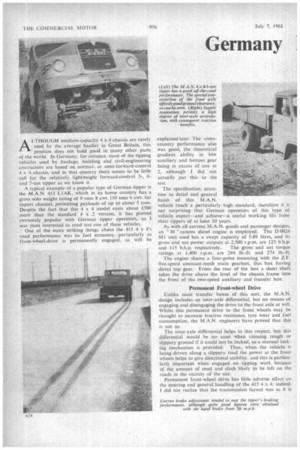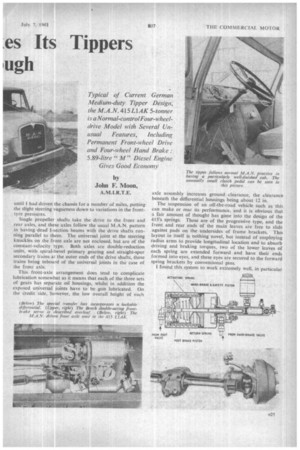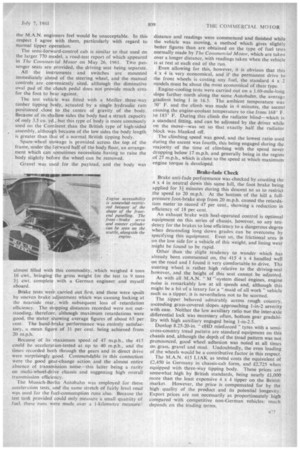Germany
Page 58

Page 59

Page 60

Page 61

If you've noticed an error in this article please click here to report it so we can fix it.
es Its Tippers
lugh
ALTHOUGH medium-capacity 4 x 4 chassis are rarely used by the average haulier, in Great Britain, this position does not hold good in many other parts of the world. In Germany, for instance, most of the tipping vehicles used by haulage, building and civil-engineering contractors are based on normalor semi-forward-control 4 x 4 chassis, and in that country there seems to be little call for the relatively lightweight forward-control 5,, band 7-ton tipper as we know it.
A typical example of a popular type of German tipper is the M.A.N. 415 Li AK, which in its home country has a gross solo weight rating of 9 tons 8 cwt. (10 tons 6 cwt. for export chassis), permitting payloads of up to about 5 tons. Despite the fact that this 4 x 4 model costs about £500 more than the standard 4 x 2 version, it has proved extremely popular with German tipper operators, so I was most interested to road test one of these vehicles.
One of the more striking things about the 415 4 x 4's road performance was its fuel economy, particularly as front-wheel-drive is permanently engaged, as will be explained later. The crosscountry performance also was good, the theoretical gradient ability in low auxiliary and bottom gear being in excess of one in 2, although I did not actually put this to the test.
The specification, attention to detail and general finish of this M.A.N. vehicle reach a particularly high standard, therefore it is not surprising that German operators of this type of vehicle expect—and achieve—a useful working life from their tippers of at least 10 years.
As with all current M.A.N. goods and passenger designs, an "M "-system diesel engine is employed. The D 0026 MI unit used has a swept capacity of 5.89 litres, and its gross and net power outputs at 2,500 r.p.m, are 123 bh-p. and 115 b.h.p. respectively. The gross and net torque ratings at 1,400 r.p.m. are 294 lb.-ft. and 274 lb.-ft.
The engine shares a four-point mounting with the Z.F. five-speed constant-mesh main gearbox, this box having direct top gear. From the rear of the box a short shaft takes the drive above the level of the chassis frame into the front of the two-speed auxiliary and transfer box.
Permanent Front-wheel Drive
Unlike most transfer boxes of this sort, the M.A.N. design includes an inter-axle differential, but no means of engaging and disengaging the drive to the front axle at will. Whilst this permanent drive to the front wheels may be thought to increase tractive resistance, tyre wear and fuel consumption, the M.A.N. engineers have proved that this is not so.
The inter-axle differential helps in this respect, but this differential would be no asset when crossing rough or slippery'ground if it could not be locked, so a manual locking mechanism is provided. Thus, when the vehicle is being driven along a slippery road the power at the front wheels helps to give directional stability, and this is particularly important when engaged on tipping work because of the amount of mud and slush likely to be left on the roads in the vicinity of the site.
Permanent front-wheel drive has little adverse effect on the steering and general handling of the 415 4 x 4: indeed. I did not realize that the transmission layout was as it is until I had driven the chassis for a number of miles, putting. the slight steering vagueness down to variations in the fronttyre pressures.
Single propeller shafts take the drive to the front and rear axles, and these axles follow the usual M.A.N. pattern in having dead I-section beams with the drive shafts running parallel to them. The universal joint at the steering knuckles on the front axle are not enclosed, but are of the constant-velocity type. Both axles are double-reduction units, with spiral-bevel primary gearing and straight-spur secondary trains at the outer ends of the drive shafts, these trains being inboard of the universal joints in the case of the front axle.
This front-axle arrangement does tend to complicate lubrication somewhat as it means that each of the three sets of gears has separate oil housings, whilst in addition the exposed universal joints have to be gun lubricated. On the credit side, however, the low overall height of each axle assembly increases ground clearance, the clearance beneath the differential housings being about 12 in.
The suspension of an off-the-road vehicle such as this can make or mar its performance, and it is obvious that a fair amount of thought has gone into the design of the 415's springs. These are of the progressive type, and the front and rear ends of the main leaves are free to slide against pads on the undersides of frame brackets. This layout in itself is nothing novel, but instead of employing radius arms to provide longitudinal location and to absorb driving and braking torques, two of the lower leaves of each spring are extended forward and have their ends formed into eyes, and these eyes are secured to the forward spring brackets by conventional pins.
I found this system to work extremely well, in particular giving a smooth ride on indifferent road surfaces, but the front springs have been found to have too low a rate characteristic, so different springs are shortly to be adopted which will be stiffer, and so reduce the tendency for the axle to rotate when braking, a characteristic which has an adverse effect on the steering. The new front springs are to be of a more simple type, pinned to the frame at their forward ends and sliding at the rear.
Leading-and-trailing-shoe brakes are used at both axles. The front brakes are hydraulically operated, and boosted by a special dual-piston, double-acting air-pressure servo. The cam-type rear brakes are actuated by an axle-mounted air cylinder. The foot-brake system is conventional, being controlled by a single valve with a treadle pedal, ,whilst the hand-brake lever acts on the rear brakes through a mechanical linkage and on the hydraulic front brakes through the air servo.
This Bosch servo requires some explanation. It contains two separate pistons, the larger of which operates the hydraulic master cylinder by spring pressure, being linked to the master-cylinder piston by a hollow piston rod. Air pressure acting on the forward face of the servo piston holds the piston back against this spring pressure, and this condition applies whenever the pressure throughout the air R26 circuit is above 60 p.s.i., and whenever the hand-brake lever is off.
Air-pressure failure, or application of the hand brake, destroys pressure in front of the piston, however, allowing the spring to move the piston, thereby applying the front brakes. Thus, the vehicle cannot be moved when the air pressure is low, although a hand valve is provided in the hydraulic circuit to release the pressure and so permit towing under such circumstances.
The foot-brake valve is piped to the back of the smaller piston in the servo assembly, and this actuates the master cylinder upon admission of air pressure to its rear face in the normal way. Each of the two servo pistons is free to move independently, being quite sealed off from each other. The two-piece, piston rod from the rear piston moves inside the hollow piston rod of the other piston.
Although M.A.N. 415 4 x 2 chassis, ranging in wheelbase from 10 ft. 6 in. to 15 ft. 9 in., are available with either semi-forwardor full-forward-control, 4 x 4 models are built with semi-forward-control only. This is because the manufacturers realize that to provide forward control the front axle would have to be moved forward, which in turn would mean raising the engine, with corresponding increase in the height of the cab above ground level, a layout which the M.A.N. engineers feel would be unacceptable. In this respect I agree with them, particularly with regard to normal tipper operation.
The semi-forward-control cab is similar to that used on the larger 770 model, a road-test report of which appeared in The Commercial Motor on May 26, 1961. Two passenger seats are provided, the driving seat being separate.
All the instruments and switches are mounted immediately ahead of the steering wheel, and the manual controls are conveniently sited, although the diminutive oval pad of the clutch pedal does not provide much area for the foot to bear. against.
The test vehicle was fitted with a MeiIler three-way timber tipping body, actuated by a single hydraulic ram positioned close to the centre of gravity of the body. Because of its shallow sides the body had a struck capacity of only 3,5 cu. yd., but this type of body is more commonly used on the Continent than the British type of high-sided assembly, although because of the low sides the body length is greater than that of a normal British tipping body.
Spare-wheel stowage is provided across the top of the frame, under the forward half of the body floor, an arrangement which can sometimes necessitate having to raise the body slightly before the wheel can be removed.
Gravel was used for the payload, and the body was almost filled with this commodity, which weighed 4 tons 16 cwt., bringing the gross weight for the test to 9 tons 34 cwt. complete with a German engineer and myself aboard.
Brake tests were carried out first, and these were spoilt by uneven brake adjustment which was causing locking at the nearside rear, with subsequent loss of retardation efficiency. The stopping distances recorded were not outstanding, therefore, although maximum retardations were good, the meter showing average figures of about 65 per cent. The hand-brake performance was entirely satisfactory, a mean figure of 31 per cent. being achieved from 20 m.p.h.
Because of its maximum speed of 47 m.p.h., the 415 could be acceleration-tested at up to 40 m.p.h., and the times recorded both through the gears and in direct drive were surprisingly good. Commendable in this connection were the good gear-change action and the almost entire absence of transmission noise--this latter being a rarity on multi-wheel-drive chassis and suggesting high overall transmission efficiency.
The Munich-Berlin Autobahn was employed for these acceleration tests, and the same stretch of fairly level road was used for the fuel-consumption runs also. Because the test tank provided could only measure a small quantity of fuel, these runs were made over a I-kilometre measured
distance and readings were commenced and finished while the vehicle was moving, a method which gives slightly better figures than are obtained on the type of fuel tests normally made by The Commercial Motor, which are taken over a longer distance, with readings taken when the vehicle is at rest at each end of the run.
Even allowing for this, however, it is obvious that this 4 x 4 is very economical, and if the permanent drive to the front wheels is costing any fuel, the standard 4 x 2 models Must be about the most economical of their type.
Engine-cooling tests were carried out on a 1.69-mile-long slope farther north along the same Autobahn., the average gradient being I in 16.5. The ambient temperature was 50° F. and the climb was made in 4 minutes, the ascent causing the engine-coolant temperature to rise from 168° F. to 183° F. During this climb the radiator blind—which is a standard fitting, and can be adjusted by the driver while on the move—was set so that exactly half the radiator block was blanked off.
The climbing speed was good, and the lowest ratio used during the ascent was fourth, this being engaged during the majority of the time of climbing with the speed never dropping below 17 m.p.h. and generally being in the region of 27 m.p.h., which is close to the speed at which maximum engine torque is developed.
Brake-fade Check Brake anti-fade performance was checked by coasting the 4 x 4 in neutral down this same hill, the foot brake being applied for 31 minutes during this descent so as to restrict the speed to 20 m.p.h. At the bottom of the hill a fullpressure foot-brake stop from 20 m.p.h. caused the retardation meter to record 47 per cent., showing a reduction in efficiency of 18 per cent.
An exhaust brake with heel-operated control is optional equipment on this series of chassis, however, so any tendency for the brakes to lose efficiency to a dangerous degree when descending long down grades can be overcome by specifying this equipment. Even so, the frictional area is on the low side for a vehicle of this weight, and lining wear might be found to be rapid.
Other than the slight tendency to wander which has already been commented on, the 415 4 x 4 handled well on the road and I found it very comfortable to drive. Thz steering wheel is rather high relative to the driving-seal however, and the height of this seat cannot be adjusted.
As with all M.A.N. " M "-system diesel engines, engine noise is remarkably low at all speeds and, although this might be a bit of a luxury for a 'maid of all work" vehicle such as a tipper, it is nevertheless not to be scorned.
The tipper behaved admirably across rough country, ascending grass-covered slopes approaching 1-in-2 severity with ease. Neither the low auxiliary ratio nor the inter-axle differential lock was necessary often, bottom gear gradability with high auxiliary engaged being 1-in-2.5.
Dunlop 8.25-20-in, "eHD reinforced" tyres with a semicross-country tread pattern are standard equipment on this chassis and, although the depth of the tread pattern was not pronounced, good wheel adhesion was noted at all times on grass, gravel and mud. Undoubtedly, the even loading of the wheels would be a contributive factor in this respect.
The M.A.N. 415 L1AK as tested costs the equivalent of £2,450 in Germany in chassis-cab form, and £2,725 when equipped with three-way tipping body. These prices are somewhat high by British standards, being nearly £1,000 more than the least expensive 4 x 4 tipper on the British market, However, the price is compensated for by the high quality of the product and its potential longevity. Export prices are not necessarily as proportionately high compared -with competitive non-German vehicles: much depends on the trading terms.




















































































































